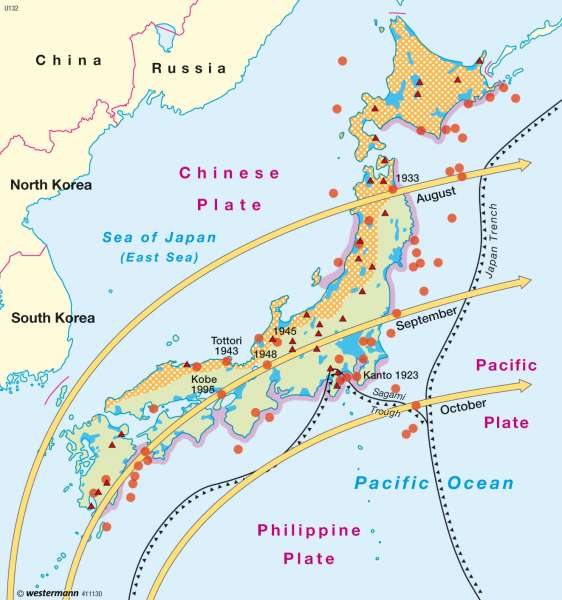Japan — Natural risks
China and Japan
978-3-14-100790-9 | Page 110 | Ill. 4

Information
Earthquakes and volcanismHardly any other state is as threatened by natural disasters as Japan. The Pacific plate collides with the Chinese plate and the Philippine plate and emerges from under both. The island state situated in the Pacific is threatened by a volcanic and earthquake "ring of fire". Each year, an average of 1,450 earthquakes are recorded in Japan. The folds of the earthquakes which occurred from 1885 to 2008 spread over the entire Japanese archipelago and the Pacific Ocean (sea floor). The entire Pacific coast of Japan is vulnerable to tsunamis. Tsunamis can also be caused by distant earthquakes and nearly 40 of over 200 volcanoes are active.As the protruding sea mountains show, more than 70 percent of Japan"s national territory is at an angle of more than 8 percent. Landslides and rockfalls occur repeatedly.
Other natural risks
On the island of Hokkaido and on the west coasts of the other islands, there is a high probability of heavy snowfall. This comes from moist air masses, which are brought by the winter monsoon from the northwest.
All the shallow coastal areas are under the threat of flooding. This threat is reinforced by the very short fetches of rivers with their high energy relief in the upper reaches and the lower incline in their lower reaches. The reasons for the regular high levels of heavy rainfall are in the unusual shifting of the polar front in early summer and autumn.
From August to October, Japan is on the parabolic orbits passage of typhoons which threaten the country with high winds, storm surges and extreme rainfall. Every year, around 30 of these tropical cyclones pass over the Japanese archipelago.
The Kobe earthquake
One of the most disastrous earthquakes ever in Japan took place on 17th January 1995 in Kobe. Despite its strength of "only" 7.2 on the Richter scale, it caused the highest total damage to date with the earthquake and subsequent fire damage estimated at about 100 billion U.S. dollars. The quakes left about 5,300 dead, approximately 215,000 buildings destroyed and the Hanshin-highway collapsed over a length of five kilometres.
H. Kiegel. E. Astor; Ü: Colette Fleming




